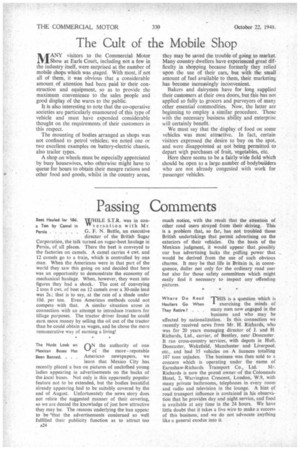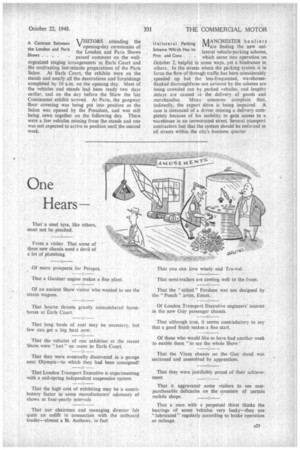Passing Comments
Page 26

Page 27

If you've noticed an error in this article please click here to report it so we can fix it.
Beet Hauled for iOd. WHILE S.T.R. was in con a Ton by Camel in "versation with Mr.
Persia G. F. N. Battle, an executive director of the British Sugar Corporation, the talk turned on sugar-beet haulage in Persia, of all places. There the beet is conveyed to the factories on camels. A camel carries 4 cwt. and 12 camels go to a train, which is controlled by one man. When the Americans were in that part of the world they saw this going on and decided that here was an opportunity to demonstrate the economy of mechanical haulage. When, however, they went into figures they had a shock.. The cost of conveying 2 tons 8 cwt. of beet on 12 camels over a 30-mile lead was 2s.; that is to say, at the rate of a shade under 10d. per ton. Even American methods could not compete with that. A similar situation arose in connection. with an attempt to introduce tractors for tillage purposes. The tractor driver found he could earn more money by selling the oil out of the tractor than he could obtain as wages, and he chose the more remunerative way of earning a living!
The Nude Look on nN the authority of one Mexican Buses Has \-1 of the more -reputable Been Banned. . . , American newspapers, we learn that Mexico City has recently placed a ban on pictures of unclothed young ladies appearing in advertisements on the backs of the Local buses. Not only is this apparently popular feature not to be extended, but the bodies beautiful already appearing had to be suitably covered by the end of August. Unfortunately the news story does not relate the suggested manner of their covering, so we are denied the knowledge of just how attractive they may be. The reasons underlying the ban appear to be 'that the advertisements conCerned so well fulfilled their publicity function as to attract too
a24
much notice, with the result that the attention of other road users strayed from their driving. This is a problem that, so far, has not troubled those British undertakings that permit advertising on the exteriors of their vehicles. On the basis of the Mexican judgment, it would appear that. pbssibly our bus advertising lacks the pulling power that would be derived from the use of such obvious charms. It may be that life in Britain is, in consequence, duller not only for the ordinary road user but also for those safety committees which might easily find it necessary to inspect any offending pictures.
Where Do Road THIS is a question which is
Hauliers Go When I exercising the minds of
They Retire ? . . many men now engaged in the business and who may be affected by nationalization. In this connection we recently received news from Mr. H. Richards, who was for 20 years managing director of I. and H. Richards, Ltd., carrier, of Bentley, near Doncaster. It ran cross-country services, with depots in Hull. Doncaster, Wakefield, Manchester and Liverpool, etc., and had 35 vehicles on A licences totalling 107 tons unladen. The business was then sold to a concern which is operating under the name of
Earnshaw-Richards Transport Co., Ltd. Mr. Richards is now the proud owner ,of the Colonnade Hotel, 2, Warrington Crescent, London, W.9, with many private bathrooms, telephones in every room and radio and television in the 'lounge. A hint of road transport influence is contained in his observation that he provides day and night service, and food is available at any time in the 24 hours. We have little doubt that it takes a live wire to make a success of this business, and we do not advocate anything like a general exodus into it.
VISITORS attending the opening-day ceremonies of the London and Paris Shows passed comment on the wellorganized staging arrangements at Earls Court and the contrasting last-minute preparations of the Paris Salon. At Earls Court, the exhibits were on the stands and nearly all the decorations and furnishings completed by 10 a.m. on the opening day. Most of the vehicles and stands had been ready two days earlier, and on the day before the Show the last Continental exhibit arrived. At Paris, the gangway floor covering was being put into position as the Salon was opened by the President, and was still being sewn together on the following day. There were a few vehicles missing from the stands and one was not expected to arrive in position until the second week.
A Contrast Between the London and Paris Shows . . . .
IVIANCHESTER hauliers "Luc finding the new urn lateral vehicle-parking scheme,
Pros and Cons . . which came into operation on October 2, helpful in some ways, yet a hindrance in others.. In the streets where the parking system is in force the flow of through traffic has been considerably speeded up but the less-frequented, warehouseflanked thoroughfares not covered by the scheme are being crowded out by parked vehicles, and lengthy delays are caused in the delivery of goods and merchandise. Many concerns complain that, indirectly, the export drive is being impaired. A case is instanced of a driver missing a delivery completely because of his inability to gain access to a warehouse in an unrestricted street. Several transport contractors feel that the system should be enforced in all streets within the city's business ginner




















































































